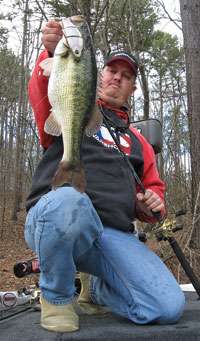
When Mike Bucca goes fishing, he sees spots. But it’s an addiction, not an affliction. While spotted bass are an incidental catch for many anglers, the guide specifically targets them in north Georgia lakes such as Lanier, Carters and Allatoona, where they predominate.
What he has learned about them and the success that he enjoys pursuing them might convince you to target them as well. And in ways that you’ve never considered. “What most people fail to realize is that the aggressiveness of a spotted bass is twice that of a largemouth and it’s the same with curiosity,” said Bucca, who has learned about spots from assisting with electrofishing surveys as well as catching them.
“Those are the No. 1 aspects that any angler can capitalize on and turn to his advantage.” Where are they? In lakes that they share, spotted bass often can be found in the same places as largemouth. But they are decidedly different fish. “The biggest difference between the two species is habitat,” said guide Mike Bucca. “Largemouth are basically shallow-water fish that love wood. Spots are much more adaptive, as they can be just as happy in shallow woody environment as they are in deep, clear environment with absolutely no cover or structure.” Look for spots, he advised, around points — especially main lake points — bluff walls and rocky shorelines. And don’t forget that they often suspend. In general, spotted bass will be deeper than largemouth, added Norm Klayman, a former tournament angler and guide who has been catching both species on Bull Shoals for nearly 40 years.
“Once they get past the spawn, they will move deeper faster than largemouth,” he said. “Sometimes, they will run open water over channels and you can catch them on top.” While largemouth like flats, Klayman said, spots tend to prefer larger rocks and hang out more along channels, especially at the ends of bluffs and chunk-rock banks.
Spot specifics
- The world record spotted bass weighed 10-4 and was caught in 2001 at Pine Flat Lake, Calif.
- Smith Lake in Alabama yielded the 20-pound test record (8-10) in 1972, but all other line-class records have some from Pine Flat and Perris, both in California, where the spotted bass, like the largemouth, is an introduced species.
- The original range for spotted bass extended from east Texas to Alabama and up into the drainages of the Mississippi and Ohio rivers.
- Spotted bass include at least two subspecies: Alabama and northern, also known as Kentucky spotted bass or just “Kentucky.”
- Spotted bass are believed to be less cold tolerant than smallmouth and largemouth.
- The name for spotted bass is derived from scale coloring below the lateral line.
- Although they seem to have smaller mouths and brighter color than largemouth, spotted bass are more accurately identified by a rough “tooth” patch on the tongue.

